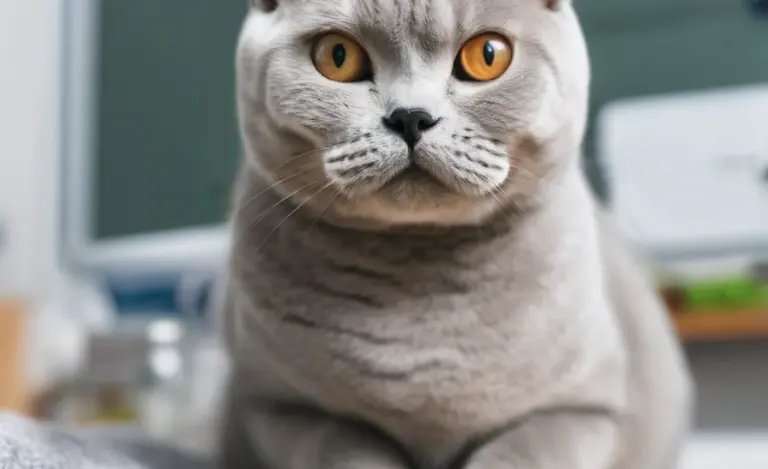Early Signs of Oral Disease in British Shorthairs: Spot Them!
The earliest signs of oral disease in British Shorthairs often include bad breath, drooling, and difficulty eating. You might also notice red or swollen gums, tartar buildup, or a change in their eating habits. Regular dental check-ups and at-home dental care are crucial for early detection and prevention.
Is your British Shorthair suddenly a bit picky about their food? Or maybe you’ve noticed their breath isn’t quite as sweet as it used to be? As loving owners, we want our furry friends to live long, happy, and healthy lives. Oral health is often overlooked, but it plays a huge role in your cat’s overall well-being. Dental problems are common in British Shorthairs, but the good news is that spotting the early signs can make a big difference.
This guide will walk you through the telltale signs of oral disease in your British Shorthair, offering simple steps you can take at home and advice on when to seek professional help. Let’s ensure those adorable British Shorthair smiles stay bright and healthy!
Understanding Oral Disease in British Shorthairs
Oral disease, also known as dental disease or periodontal disease, is a very common health issue in cats, including our beloved British Shorthairs. It’s not just about bad breath; it can lead to serious health problems if left untreated.
What is Oral Disease?
Oral disease starts with plaque, a sticky film of bacteria that forms on the teeth. If plaque isn’t removed through regular cleaning, it hardens into tartar (calculus). Tartar irritates the gums, leading to gingivitis (inflammation of the gums). Over time, gingivitis can progress to periodontitis, which affects the tissues and bone that support the teeth. This can cause pain, tooth loss, and even systemic health issues.
Why British Shorthairs are Prone to Oral Disease
British Shorthairs, like many purebred cats, can be more prone to dental issues due to genetic factors and their breed characteristics. Some reasons they might be more susceptible include:
- Genetics: Certain genetic predispositions can make them more likely to develop dental problems.
- Crowded Teeth: The structure of their mouth can sometimes lead to crowded teeth, making it easier for plaque and tartar to build up.
- Diet: While not exclusive to the breed, diet plays a big role; cats eating primarily soft food may have more plaque buildup compared to those eating dry food.
Stages of Oral Disease
Understanding the stages of oral disease can help you identify problems early and take appropriate action. Here’s a breakdown:
- Gingivitis: This is the earliest stage, characterized by red, swollen gums. It’s often reversible with professional cleaning and good home care.
- Early Periodontitis: The gums start to pull away from the teeth, forming pockets that trap bacteria and food particles.
- Moderate Periodontitis: There is further loss of attachment between the gums and teeth, with more significant inflammation and potential bone loss.
- Advanced Periodontitis: This is the most severe stage, with significant bone loss, loose teeth, and chronic pain. Tooth extraction is often necessary.
Early Signs of Oral Disease
Catching oral disease early can save your British Shorthair from a lot of pain and discomfort. Here are the key signs to watch for:
- Bad Breath (Halitosis): One of the first and most noticeable signs. Healthy cat breath shouldn’t be offensive.
- Red or Swollen Gums (Gingivitis): Healthy gums are pink and firm. Redness and swelling indicate inflammation.
- Tartar Buildup: Yellow or brown deposits on the teeth, especially near the gum line.
- Drooling: Excessive drooling, especially if it’s tinged with blood.
- Difficulty Eating: Hesitation to eat, chewing on one side of the mouth, or dropping food.
- Weight Loss: Reduced appetite due to oral pain can lead to weight loss.
- Pawing at the Mouth: Your cat may paw at their mouth or rub their face against furniture.
- Changes in Grooming Habits: Neglecting grooming, especially around the face, can be a sign of discomfort.
- Irritability: Pain can make your cat more irritable or withdrawn.
How to Check Your British Shorthair’s Mouth
Regularly checking your cat’s mouth at home can help you spot early signs of oral disease. Here’s how to do it:
- Choose a Calm Time: Pick a time when your cat is relaxed and receptive.
- Gather Your Supplies: You’ll need good lighting and a gentle approach.
- Lift the Lip: Gently lift your cat’s upper lip to examine the gums and teeth. Repeat on the lower lip.
- Check the Gums: Look for redness, swelling, or bleeding. Healthy gums should be pink and firm.
- Examine the Teeth: Check for tartar buildup, discoloration, or broken teeth.
- Look for Any Abnormalities: Note any unusual lumps, bumps, or sores.
- Reward Your Cat: Give your cat a treat or praise to make the experience positive.
| Area to Check | What to Look For | What it Could Indicate |
|---|---|---|
| Gums | Redness, swelling, bleeding | Gingivitis, inflammation |
| Teeth | Tartar buildup, discoloration, chips or cracks | Dental disease, damage |
| Breath | Foul odor | Bacterial infection, dental disease |
| Saliva | Excessive drooling, blood | Oral pain, infection |
At-Home Dental Care for British Shorthairs
Maintaining good oral hygiene at home is crucial for preventing oral disease. Here are some effective strategies:
Brushing Your Cat’s Teeth
Brushing is the gold standard for at-home dental care. Here’s how to introduce it to your British Shorthair:
- Start Slowly: Begin by getting your cat used to you touching their mouth.
- Use Cat-Friendly Toothpaste: Never use human toothpaste, as it can be harmful to cats. Use toothpaste specifically formulated for cats.
- Introduce the Toothbrush: Let your cat sniff and lick the toothbrush.
- Brush Gently: Gently brush the teeth in a circular motion, focusing on the gum line.
- Keep it Short: Start with a few seconds and gradually increase the duration.
- Reward Your Cat: Always end with praise and a treat.
Dental Treats and Toys
Dental treats and toys can help reduce plaque and tartar buildup. Look for products approved by the Veterinary Oral Health Council (VOHC). These treats and toys are designed to promote chewing, which helps to scrape away plaque. Always supervise your cat when they’re using dental toys to ensure they don’t ingest any small parts.
Dental Diets
Certain dry cat foods are formulated to promote dental health. These diets often contain larger kibble sizes that encourage chewing and help to clean the teeth. They may also contain ingredients that help to prevent tartar formation. Talk to your vet about whether a dental diet is right for your British Shorthair.
Water Additives
Water additives can help to reduce plaque and tartar buildup. These products are added to your cat’s water bowl and work by killing bacteria in the mouth. Look for water additives that are approved by the VOHC. Always follow the instructions on the label and monitor your cat for any adverse reactions.
When to See a Vet
While at-home dental care is important, it’s not a substitute for professional dental cleanings. Regular veterinary check-ups are essential for maintaining your British Shorthair’s oral health. Here’s when you should schedule a visit:
- Annual Check-ups: Your vet can assess your cat’s oral health during their annual check-up.
- Signs of Oral Disease: If you notice any signs of oral disease, such as bad breath, red gums, or difficulty eating, schedule an appointment right away.
- Professional Cleaning: Your vet may recommend a professional dental cleaning under anesthesia to remove tartar and plaque buildup.
- Tooth Extractions: If your cat has severe dental disease, tooth extractions may be necessary to relieve pain and prevent further complications.
Professional Dental Cleaning
A professional dental cleaning, also known as a prophylaxis, is a thorough cleaning of your cat’s teeth performed by a veterinarian or a veterinary technician under anesthesia. Here’s what to expect:
- Pre-Anesthetic Exam: Your vet will perform a physical exam and blood tests to ensure your cat is healthy enough for anesthesia.
- Anesthesia: Your cat will be placed under general anesthesia to ensure they remain still and comfortable during the procedure.
- Scaling: The vet will use specialized instruments to remove tartar and plaque from above and below the gum line.
- Polishing: The teeth will be polished to smooth the surface and prevent plaque from adhering.
- Fluoride Treatment: A fluoride treatment may be applied to strengthen the enamel and protect against decay.
- Examination: The vet will examine the mouth for any signs of disease, such as gingivitis, periodontitis, or tumors.
- Post-Cleaning Care: Your vet will provide instructions for at-home dental care to help maintain your cat’s oral health.
Preventative Measures
Preventing oral disease is always better than treating it. Here are some preventative measures you can take to keep your British Shorthair’s mouth healthy:
- Regular Brushing: Brush your cat’s teeth daily, if possible, to remove plaque and prevent tartar buildup.
- Dental Treats and Toys: Provide dental treats and toys to help clean the teeth and stimulate the gums.
- Dental Diet: Feed a dental diet to help reduce plaque and tartar formation.
- Water Additives: Use water additives to kill bacteria in the mouth.
- Regular Veterinary Check-ups: Schedule annual check-ups with your vet to assess your cat’s oral health and catch any problems early.
- Professional Cleaning: Follow your vet’s recommendations for professional dental cleanings.
FAQ About Oral Disease in British Shorthairs
Q: How often should I brush my British Shorthair’s teeth?
A: Ideally, you should brush your cat’s teeth daily. However, even brushing a few times a week can make a big difference.
Q: What kind of toothpaste should I use for my cat?
A: Always use toothpaste specifically formulated for cats. Human toothpaste contains ingredients that can be harmful to cats.
Q: Are dental treats and toys effective for preventing oral disease?
A: Yes, dental treats and toys can help reduce plaque and tartar buildup. Look for products approved by the Veterinary Oral Health Council (VOHC).
Q: How often should my cat have a professional dental cleaning?
A: The frequency of professional dental cleanings depends on your cat’s individual needs. Your vet can recommend a cleaning schedule based on your cat’s oral health.
Q: Can oral disease affect my cat’s overall health?
A: Yes, oral disease can lead to serious health problems, such as heart disease, kidney disease, and liver disease. Bacteria from the mouth can enter the bloodstream and spread to other organs.
Q: What are the risks of anesthesia for dental cleaning?
A: Anesthesia always carries some risks, but modern anesthesia protocols are very safe. Your vet will perform a thorough pre-anesthetic exam and monitor your cat closely during the procedure to minimize risks. The benefits of a dental cleaning usually outweigh the risks of anesthesia.
Q: My cat hates having their teeth brushed. What can I do?
A: Start slowly and make the experience positive. Use cat-friendly toothpaste, brush gently, and reward your cat with praise and treats. If your cat is resistant, try using a finger brush or dental wipes instead of a toothbrush.
Conclusion
Taking care of your British Shorthair’s oral health is an essential part of responsible pet ownership. By understanding the early signs of oral disease and implementing a consistent at-home dental care routine, you can help keep their smile bright and their body healthy. Regular veterinary check-ups and professional cleanings are also crucial for preventing and treating dental problems. Remember, a healthy mouth contributes to a happier, healthier life for your beloved British Shorthair. So, keep an eye out for those early signs, and take action to ensure your furry friend enjoys a lifetime of good oral health!




